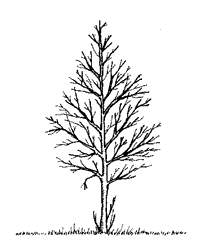The best time to train trees by pruning is when they are young. Properly done, it will help you avoid major corrective pruning when the tree is older.
 |
| Before Pruning |
Do not prune newly transplanted trees. This practice, once recommended by nurseries to reduce transplant stress, is no longer encouraged.
Remove all "water sprouts" (vertical limbs growing off of horizontal limbs) and remove all “suckers” growing out of the base of the tree so that one strong main stem is left.
Remove branches that grow at sharp angles to the main trunk. These narrow crotches are more apt to break off in storms in later years. Ideally, all branches should extend about 45 degrees from the main trunk.
 |
| After Pruning |
Trim one of two limbs growing too closely together; "too close" will vary from species to species, but any limbs closer than 6 inches to each other are suspect. As a general rule, evenly space lateral branches more than 12 inches apart to ensure that each branch receives the sunshine and moisture it needs.
Remember that branches do not move upward as the tree grows taller. If a limb is headed toward a house or other structure, remove it early in the life of the tree or it will continue to grow and spread outward at the same height as the tree matures.

